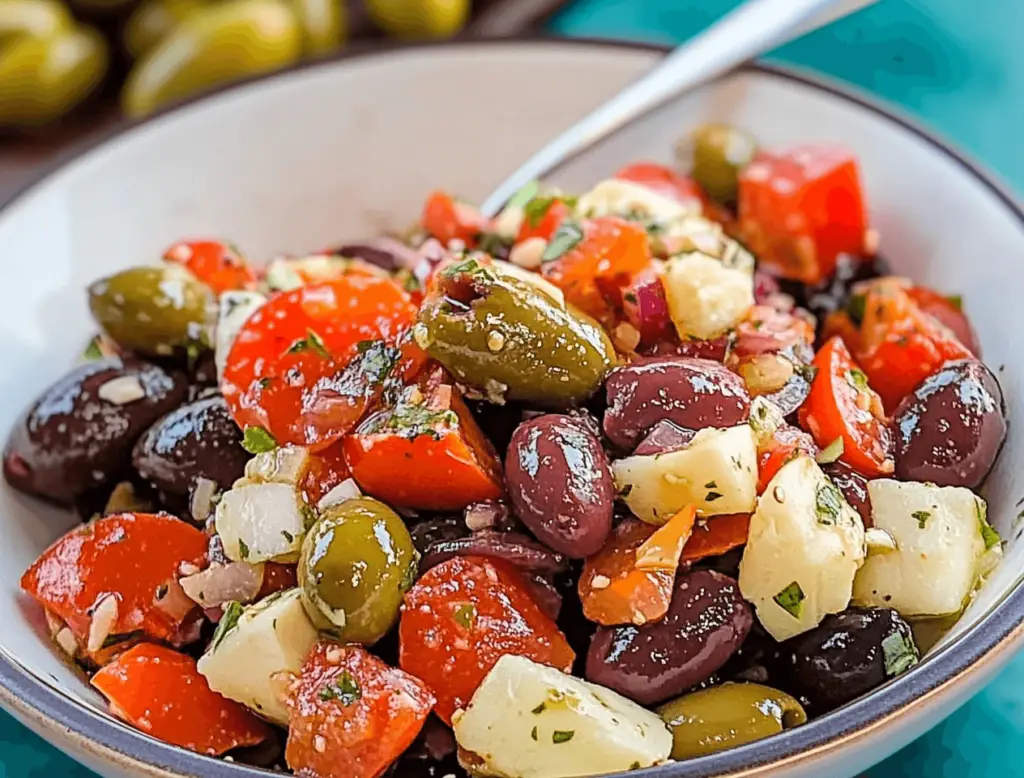Olive Salad is a vibrant and flavorful dish that can be enjoyed as a side, a topping for sandwiches, or a dip for crackers and bread. This salad is a staple in Mediterranean cuisine and is packed with the briny goodness of mixed olives, complemented by fresh vegetables and herbs. Whether you’re preparing it for a party or just a simple meal at home, Olive Salad is easy to make and can be customized to your taste.

Overview of Olive Salad
Olive Salad is typically made with a mix of green and black olives, chopped finely and combined with vegetables like bell peppers, celery, and onions. The salad is then dressed with olive oil, vinegar, and a blend of Italian herbs. The result is a tangy, savory salad with a crunchy texture and a burst of flavors in every bite. It’s perfect as a topping for sandwiches like muffulettas, or as a standalone appetizer served with crusty bread.
Brief History and Inspiration Behind Olive Salad
Olive Salad is inspired by the bold flavors of Mediterranean cuisine, where olives are a central ingredient. This salad, often associated with the famous New Orleans muffuletta sandwich, has become popular in various forms worldwide. The combination of olives with pickled vegetables and aromatic herbs creates a dish that’s both versatile and packed with flavor.
Preparation Phase & Tools to Use
Recipe Details
- Prep Time: 15 minutes
- Cook Time: None (optional chilling time: 30 minutes)
- Total Time: 15-45 minutes
- Servings: 4-6 servings
- Yield: 4 cups Olive Salad
Essential Tools and Equipment
To make Olive Salad, you’ll need the following tools:
- Chef’s Knife: For chopping olives and vegetables.
- Cutting Board: To provide a stable surface for chopping.
- Mixing Bowl: For combining the salad ingredients.
- Measuring Cups/Spoons: To measure out the ingredients accurately.
- Jar with Lid: If you plan to store the salad or want to shake the dressing together.
Importance of Each Tool
- Chef’s Knife: A sharp knife ensures clean, even cuts, which helps in achieving the right texture for the salad.
- Cutting Board: A stable cutting board makes the preparation process safer and more efficient.
- Mixing Bowl: A large bowl allows you to mix the salad thoroughly, ensuring that all ingredients are evenly distributed.
- Jar with Lid: Useful for mixing the dressing ingredients by shaking and storing the salad for later use.
Preparation Tips
- Use Pitted Olives: Save time by using pitted olives, or pit them yourself before chopping.
- Customize Your Salad: Add more or fewer ingredients based on your preference. For example, you can add capers for extra brininess or artichoke hearts for more texture.
- Chill for Best Flavor: Let the salad sit in the refrigerator for at least 30 minutes before serving. This allows the flavors to meld together.
Ingredients List
- 1 cup green olives, pitted and chopped
- 1 cup black olives, pitted and chopped
- 1/2 cup roasted red peppers, chopped
- 1/2 cup celery, finely diced
- 1/4 cup red onion, finely diced
- 1/4 cup Italian giardiniera, chopped
- 2 tablespoons capers, drained
- 1/4 cup fresh parsley, chopped
- 1/4 cup extra virgin olive oil
- 2 tablespoons red wine vinegar
- 1 teaspoon dried oregano
- 1/2 teaspoon dried thyme
- Salt and pepper to taste
Step-by-Step Instructions
- Chop the ingredients: On a cutting board, chop the green and black olives, roasted red peppers, celery, red onion, giardiniera, and parsley.
- Combine in a bowl: In a large mixing bowl, combine the chopped ingredients with the capers.
- Prepare the dressing: In a small jar or bowl, whisk together the olive oil, red wine vinegar, oregano, thyme, salt, and pepper. Shake or stir until well combined.
- Mix the salad: Pour the dressing over the olive mixture and toss until everything is evenly coated.
- Chill: For best flavor, cover the salad and let it chill in the refrigerator for at least 30 minutes before serving.
- Serve: Serve as a side dish, on top of sandwiches, or as an appetizer with crackers or bread.
Side Dish Recommendations
Olive Salad is a bold and flavorful dish that can stand on its own or be paired with a variety of side dishes. Here are some side dish ideas that complement the rich, briny flavors of olive salad, making for a complete and satisfying meal:
1. Grilled Chicken Skewers
Grilled chicken skewers are a perfect match for Olive Salad. The smoky, savory flavor of the chicken complements the tangy, briny olives, creating a balanced and hearty dish. You can marinate the chicken in a lemon-herb marinade to tie the flavors together.
2. Pita Bread and Hummus
Serve Olive Salad alongside warm pita bread and creamy hummus for a classic Mediterranean experience. The soft, fluffy pita is perfect for scooping up the salad, while the hummus adds a smooth, nutty flavor that pairs well with the olives.
3. Greek Salad
A fresh Greek salad with tomatoes, cucumbers, red onions, and feta cheese is a great complement to Olive Salad. The crisp vegetables and creamy feta add contrasting textures and flavors that enhance the overall meal. A light lemon vinaigrette ties it all together.
4. Roasted Vegetables
Roasted vegetables such as zucchini, eggplant, and bell peppers add a sweet and earthy flavor that pairs beautifully with Olive Salad. The caramelized edges of the roasted vegetables provide a nice contrast to the briny olives and crisp vegetables in the salad.
5. Grilled Fish
Lightly seasoned grilled fish, such as tilapia, sea bass, or salmon, is an excellent protein option to serve with Olive Salad. The light, flaky texture of the fish balances the bold flavors of the salad, making for a refreshing and satisfying meal.
6. Couscous or Quinoa
Couscous or quinoa is a great grain to serve alongside Olive Salad. These grains soak up the dressing from the salad, making for a flavorful and nutritious side. You can also add fresh herbs like parsley or mint to the grains for extra flavor.
7. Cheese Platter
A cheese platter featuring a variety of cheeses such as feta, goat cheese, and manchego can be a fantastic addition to Olive Salad. The rich and creamy cheeses pair well with the tangy, briny olives, adding a luxurious touch to your meal.
Nutritional Information & Health Benefits
Understanding the nutritional content of Olive Salad and its side dishes can help you enjoy this dish as part of a balanced and healthy diet.
- Calories: Olive Salad is relatively low in calories, typically containing around 100-150 calories per serving, depending on the ingredients used.
- Healthy Fats: Olives are a rich source of monounsaturated fats, which support heart health and provide sustained energy.
- Fiber: The vegetables and olives in the salad contribute to its fiber content, which aids digestion and helps you feel fuller longer.
- Vitamins and Antioxidants: Olives, peppers, and other vegetables in the salad are high in vitamins A, C, and E, as well as antioxidants that protect the body from oxidative stress and support overall health.
Health Benefits
- Heart Health: The monounsaturated fats in olives help lower bad cholesterol levels and reduce the risk of heart disease, making Olive Salad a heart-healthy choice.
- Anti-Inflammatory Properties: The antioxidants in olives and vegetables have anti-inflammatory effects, which can help reduce the risk of chronic diseases like heart disease and cancer.
- Digestive Health: The fiber in Olive Salad aids in digestion and helps maintain a healthy gut, which is important for overall wellness.
Common Mistakes to Avoid & How to Perfect the Recipe
1. Overdressing the Salad
- Mistake: Adding too much dressing can make the salad too oily and overpower the flavors of the olives and vegetables.
- Solution: Start with a small amount of dressing, toss the salad, and add more as needed. The ingredients should be lightly coated, not drenched.
2. Using Low-Quality Olives
- Mistake: Using low-quality or overly salty olives can result in a salad that’s too salty and lacks depth of flavor.
- Solution: Use high-quality, pitted olives from a reputable brand or deli. You can also mix different types of olives, such as Kalamata, Castelvetrano, and green olives, to add complexity to the flavor.
3. Skipping the Chill Time
- Mistake: Serving the salad immediately without chilling can prevent the flavors from fully melding together.
- Solution: Let the salad chill in the refrigerator for at least 30 minutes before serving. This allows the flavors to develop and intensify, making the salad more flavorful.
4. Not Balancing the Acidity
- Mistake: If the salad is too acidic from the vinegar, it can overpower the other flavors and make the salad taste too sharp.
- Solution: Adjust the acidity by adding a bit more olive oil or a pinch of sugar to balance the flavors. Taste as you go to ensure the right balance of acidity and richness.
5. Overloading with Ingredients
- Mistake: Adding too many ingredients can make the salad overwhelming and detract from the distinct flavors of the olives and key vegetables.
- Solution: Keep the salad simple, focusing on the olives and a few complementary ingredients. This allows the distinct flavors to shine through and ensures a balanced taste.
Tips, Notes, Storing, and Reheating
Tips for Perfect Olive Salad
- Use High-Quality Olives: The flavor of your Olive Salad largely depends on the quality of the olives you use. Opt for a variety of olives, such as Kalamata, Castelvetrano, and green olives, for a complex flavor profile.
- Balance the Flavors: Taste the salad as you mix it to ensure the right balance of acidity, saltiness, and richness. Adjust with more olive oil, vinegar, or a pinch of sugar if necessary.
- Let It Marinate: For the best flavor, allow the salad to marinate in the refrigerator for at least 30 minutes. This gives the ingredients time to meld together, enhancing the overall taste.
- Add Fresh Herbs: Fresh herbs like parsley, basil, or oregano can elevate the salad, adding brightness and freshness to the rich olive flavors.
Notes on Ingredients and Variations
- Add Some Crunch: For additional texture, consider adding chopped nuts like almonds or pine nuts, or even diced celery for a bit of crunch.
- Sweetness: If you prefer a touch of sweetness, add dried cranberries or golden raisins to contrast with the briny olives.
- Cheese Addition: Crumbled feta or goat cheese can be added for a creamy, tangy element that pairs well with the olives.
Storing Olive Salad
- Refrigeration: Store Olive Salad in an airtight container in the refrigerator for up to 5 days. The flavors will continue to develop as the salad sits, making it even tastier after a day or two.
- Freezing: Freezing is not recommended for Olive Salad as the texture of the olives and vegetables can change upon thawing, resulting in a less appealing dish.
Reheating Olive Salad
- No Reheating Needed: Olive Salad is best served chilled or at room temperature, so there’s no need to reheat it. If it has been stored in the refrigerator, let it sit at room temperature for about 15 minutes before serving to allow the flavors to come through.
FAQs
1. Can I make Olive Salad ahead of time?
Yes, Olive Salad actually improves in flavor when made ahead of time. Prepare it a day in advance and store it in the refrigerator to allow the flavors to meld together.
2. What can I do if my Olive Salad is too salty?
If your salad is too salty, you can balance it out by adding more vegetables like diced tomatoes or cucumbers. You can also add a bit of sugar or a splash of lemon juice to counteract the saltiness.
3. Can I use jarred olives for this recipe?
Yes, jarred olives work well for Olive Salad. Just be sure to drain them well, and give them a quick rinse if they’re packed in brine to reduce excess saltiness.
4. How do I serve Olive Salad?
Olive Salad can be served as a side dish, a topping for sandwiches, or as an appetizer with crusty bread or crackers. It’s also a great addition to antipasto platters.
5. What can I pair with Olive Salad for a complete meal?
Pair Olive Salad with grilled chicken, fish, or lamb for a complete Mediterranean-inspired meal. It also goes well with couscous, quinoa, or a fresh green salad.
Conclusion
Olive Salad is a versatile and flavorful dish that’s perfect for any occasion. With its rich, briny flavors and fresh, crisp vegetables, it can be served as a side dish, appetizer, or even a topping for sandwiches. By following the tips and instructions provided, you can create a delicious and well-balanced olive salad that will impress your guests and elevate your meal.
Print
Olive Salad
Description
Discover how to make a vibrant Olive Salad! This Mediterranean dish is packed with briny olives, fresh veggies, and herbs. Perfect as a side or appetizer.
Ingredients
Ingredients List
- 1 cup green olives, pitted and chopped
- 1 cup black olives, pitted and chopped
- 1/2 cup roasted red peppers, chopped
- 1/2 cup celery, finely diced
- 1/4 cup red onion, finely diced
- 1/4 cup Italian giardiniera, chopped
- 2 tablespoons capers, drained
- 1/4 cup fresh parsley, chopped
- 1/4 cup extra virgin olive oil
- 2 tablespoons red wine vinegar
- 1 teaspoon dried oregano
- 1/2 teaspoon dried thyme
- Salt and pepper to taste
Instructions
- Chop the ingredients: On a cutting board, chop the green and black olives, roasted red peppers, celery, red onion, giardiniera, and parsley.
- Combine in a bowl: In a large mixing bowl, combine the chopped ingredients with the capers.
- Prepare the dressing: In a small jar or bowl, whisk together the olive oil, red wine vinegar, oregano, thyme, salt, and pepper. Shake or stir until well combined.
- Mix the salad: Pour the dressing over the olive mixture and toss until everything is evenly coated.
- Chill: For best flavor, cover the salad and let it chill in the refrigerator for at least 30 minutes before serving.
- Serve: Serve as a side dish, on top of sandwiches, or as an appetizer with crackers or bread.
Notes
- Use High-Quality Olives: The flavor of your Olive Salad largely depends on the quality of the olives you use. Opt for a variety of olives, such as Kalamata, Castelvetrano, and green olives, for a complex flavor profile.
- Balance the Flavors: Taste the salad as you mix it to ensure the right balance of acidity, saltiness, and richness. Adjust with more olive oil, vinegar, or a pinch of sugar if necessary.
- Let It Marinate: For the best flavor, allow the salad to marinate in the refrigerator for at least 30 minutes. This gives the ingredients time to meld together, enhancing the overall taste.
- Add Fresh Herbs: Fresh herbs like parsley, basil, or oregano can elevate the salad, adding brightness and freshness to the rich olive flavors.


Leave a Comment